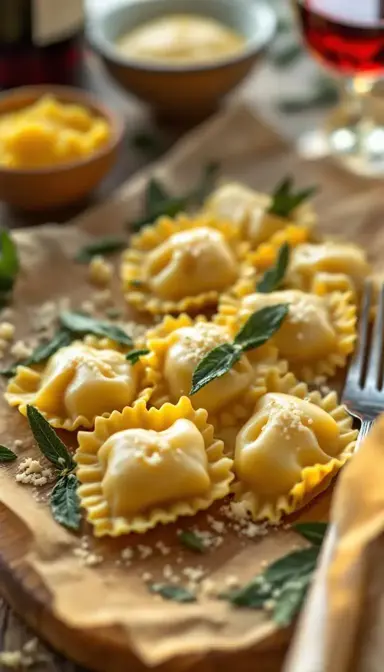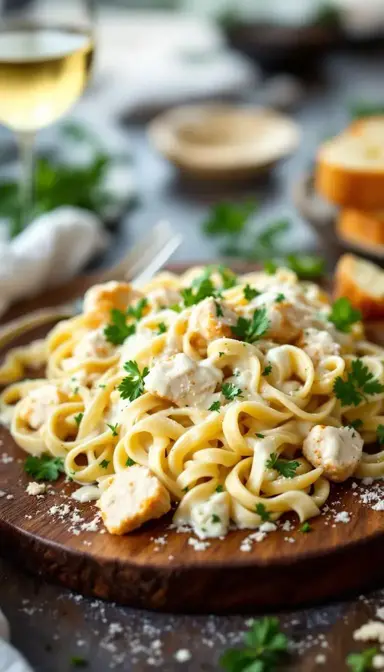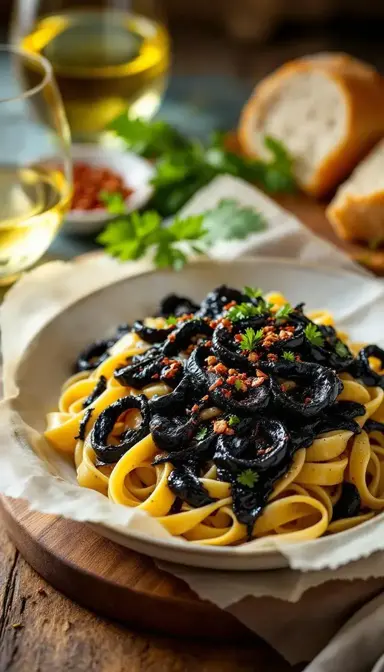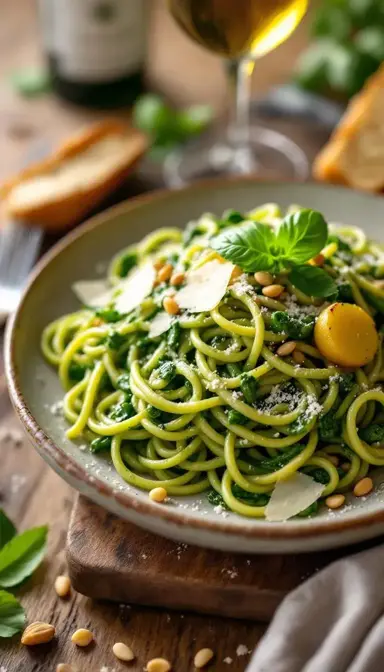Picture this: the scent of golden butter and fresh sage dancing through your kitchen as tiny, handcrafted pasta parcels bob gently in a pot of simmering water. That first bite? Pure magic. Agnolotti del Plin, the crown jewel of Piedmontese cooking, is more than just pasta—it’s a labor of love, a bite-sized treasure chest of rich, savory filling wrapped in tender dough. These little pinched ravioli aren’t just food; they’re a connection to generations of Italian grandmothers who turned humble ingredients into something extraordinary. Today, we’re rolling up our sleeves and diving into the art of making authentic Agnolotti del Plin, from silky dough to that unforgettable sage-kissed finish.
Why This Recipe Works
- Handmade elegance: There’s nothing quite like the satisfaction of crafting pasta from scratch.
- Flavor that lingers: Roasted meats, nutty Parmigiano, and a whisper of nutmeg create a filling that’s deep and soulful.
- Versatility: Change up the fillings with the seasons or stick to the classic—it’s always a showstopper.
The Story Behind the Sauce
Born in the rolling hills of Piedmont, Agnolotti del Plin (literally “pinched agnolotti”) started as a thrifty way to use up leftover roast meats. Those clever Italian cooks tucked shreds of meat into pasta squares, pinched them shut, and created a dish that’s now celebrated around the world. Every bite is a taste of history.
Essential Ingredients & Tools
Ingredients for the Pasta Dough
- 300g 00 flour (or all-purpose flour in a pinch)
- 3 large eggs (about 180g total—farm-fresh if you can get them)
- 5g fine sea salt (just enough to enhance, not overpower)
- 10g olive oil (optional, but it adds a lovely suppleness)
Ingredients for the Filling
- 200g finely minced roast meats (veal, pork, or even chicken for a lighter twist)
- 60g Parmigiano Reggiano (or Pecorino Romano for a sharper bite)
- 1 large egg yolk (for richness and binding)
- A whisper of freshly grated nutmeg
- 20g fine dry breadcrumbs (or panko for extra crunch)
- 2–3 tbsp reserved meat juices or broth (or vegetable broth for a vegetarian version)
- Salt and black pepper to taste
Ingredients for the Sage Butter Sauce
- 100g unsalted butter (or ghee for a nuttier flavor)
- 15–20 fresh sage leaves (or 1 tsp dried sage in a pinch)
- Extra Parmigiano Reggiano for serving
Tools You’ll Need
- Pasta roller or a rolling pin (a wine bottle works in a pinch)
- Bench scraper or a sharp knife for cutting dough
- Pastry brush or your fingertip for egg wash
- Fluted ravioli cutter or a sharp knife
- Large pot and skillet
Serves: 4 | Prep: 90 min | Cook: 10 min | Total: 100 min
How to Make Agnolotti del Plin
- Making the Pasta Dough
Start by piling your 300g 00 flour into a mound on a clean surface, then carve out a well in the center—like a tiny flour volcano. Crack the 3 large eggs into the crater, add the 5g fine sea salt and 10g olive oil if using, and gently whisk with a fork, slowly pulling in flour from the sides. Once it starts to come together, knead by hand for 8–10 minutes until it’s smooth and elastic. This is where the magic happens—the gluten develops, giving your pasta that perfect chew. If the dough feels dry, dampen your fingers slightly; if it’s sticky, a light dusting of flour will do the trick. Wrap it in plastic and let it rest for 30 minutes. This isn’t just downtime—it’s letting the gluten relax so your dough rolls out like a dream.
- Preparing the Filling
Take your 200g roasted meats and mince them until they’re as fine as confetti—no big chunks here. Mix them with the 60g Parmigiano, 1 large egg yolk, pinch of nutmeg, and 20g breadcrumbs, then drizzle in the 2–3 tbsp reserved meat juices until it all holds together like a spreadable pâté. Season it boldly—pasta has a way of muting flavors, so the filling should taste a touch saltier than you’d normally like. To test, microwave a tiny spoonful and adjust as needed.
- Rolling Out the Pasta Sheets
Divide the dough into 4 equal portions—it’s easier to work with smaller pieces. Flatten one into a rectangle, then run it through your pasta machine starting at the widest setting. After each pass, fold it into thirds like a letter—this laminates the dough, making it stronger. Keep rolling until you reach setting 6 or 7 (about 1mm thick). You’re aiming for sheets so thin you can almost see through them, but still sturdy enough to hold the filling. If the edges crack, a spritz of water and a quick re-roll will fix it.
- Filling and Pinching
Lay one sheet on a floured surface and brush the lower half with egg wash (1 beaten egg + 1 tsp water). Place 1 tsp mounds of filling about an inch apart. Fold the top half over, pressing around each mound to push out any air—trapped steam is the enemy here. Now, the signature move: pinch firmly between the fillings with your thumb and forefinger, using your other hand to support the back. You’re going for a little pleated pillow look—that’s the “plin” in action. Trim the edges with a fluted cutter for that authentic touch.
- Cooking to Perfection
Bring a large pot of heavily salted water (it should taste like the sea) to a gentle simmer—no roaring boils here, or you’ll tear your delicate pasta. Cook in batches for 2–4 minutes until they float and the edges are al dente (firm but not crunchy). Save some pasta water—it’s liquid gold for adjusting your sauce later.
- The Sage Butter Finish
Melt 100g unsalted butter in a skillet over medium heat until it turns a toasty golden-brown and smells nutty—that’s beurre noisette, and it’s a game-changer. Toss in the 15–20 fresh sage leaves and let them crisp for about 30 seconds. Add your cooked agnolotti, swirling them in the butter and adding splashes of pasta water to create a glossy, clingy sauce. Serve immediately with a generous snowfall of Parmigiano Reggiano.
Pro Technique
The Pinch That Makes the Difference
The “plin” technique isn’t just for looks—it’s what keeps your filling snug inside its pasta blanket. After folding the sheet, press firmly around each mound, working outward to banish air pockets. Pinch vertically between fillings while supporting the back with your other hand. This creates a tight, ruffled seal that locks in all that flavor. For extra security, dab the edges with egg wash before pinching.
Rolling Like a Pro
Getting the right thickness takes patience. Your sheets should be thin enough to almost read through but sturdy enough to survive the boil. Roll progressively, alternating directions to avoid uneven thinning. If you get a tear, don’t panic—a dab of water and a scrap of dough will patch it right up. And remember: less flour is more. Too much and your dough won’t stick together properly.
Chef’s Wisdom
The Power of Resting
Never skip the 30-minute dough rest. This lets the gluten relax, so your dough won’t fight you when you roll it. If it’s still stubborn, cover it with a damp towel for another 10 minutes. Hot kitchen? Pop it in the fridge—cool dough is easier to handle.
Filling Consistency is Key
Your filling should hold its shape when scooped but spread lightly when pressed. Too wet? Add breadcrumbs. Too dry? More broth. And always over-season slightly—pasta dulls flavors, so your filling needs to be bold. For a veggie version, roast your vegetables to concentrate their flavors and blot any excess moisture.
Perfect Pairings
Complementary Dishes
- Bitter Greens Salad: A crisp tangle of radicchio or arugula with a lemon vinaigrette cuts through the richness of the butter sauce. The bitterness is the perfect counterpoint to the savory filling.
- Creamy Polenta: A side of silky polenta adds comforting contrast. The mild corn flavor lets the nutty Parmigiano shine.
Drinks
- Barbera d’Alba: This Piedmontese red wine’s bright acidity and cherry notes slice through the dish’s richness. Serve it slightly chilled.
- Arneis: A floral, dry white wine from Piedmont that echoes the sage’s herbal notes without overpowering the pasta.
Something Sweet
- Hazelnut Budino: A Piedmontese hazelnut pudding mirrors the region’s nutty flavors. Its creamy texture is the perfect foil to the pasta’s bite.
- Espresso Affogato: A shot of hot espresso over Vanilla Gelato cleanses the palate with its bold, bittersweet finish.
FAQs
- Q: Can I use store-bought pasta sheets?
A: Homemade is ideal, but in a pinch, thin lasagna sheets can work—just make sure they’re fresh and pliable. - Q: How do I prevent my agnolotti from bursting during cooking?
A: Avoid overfilling and make sure your seals are tight. Air pockets are the enemy—press them out firmly. - Q: Can I freeze Agnolotti del Plin?
A: Absolutely! Freeze them uncooked on a tray first, then transfer to bags. They’ll keep for months.

Agnolotti del Plin: The Soulful Pinched Pasta of Piedmont
Master Agnolotti del Plin with my step-by-step guide to handmade pasta, savory fillings, and that iconic sage butter finish. Taste the soul of Piedmont!
Ingredients
For the Pasta Dough
-
300 g 00 flour
-
3 large eggs
-
5 g fine sea salt
-
10 g olive oil (optional)
For the Filling
-
200 g finely minced roast meats
-
60 g Parmigiano Reggiano
-
1 large egg yolk
-
Pinch freshly grated nutmeg
-
20 g fine dry breadcrumbs
-
2–3 tbsp reserved meat juices or broth
-
Salt and black pepper (to taste)
For the Sage Butter Sauce
-
100 g unsalted butter
-
15–20 fresh sage leaves
-
Extra Parmigiano Reggiano (for serving)
Instructions
-
Make the pasta dough by forming a flour well, adding eggs, salt, and oil, then kneading until smooth. Rest for 30 minutes.01
-
Prepare the filling by mixing minced meats, Parmigiano, egg yolk, nutmeg, breadcrumbs, and broth. Season boldly.02
-
Roll dough into thin sheets, fold, and laminate for strength.03
-
Fill and pinch agnolotti, ensuring tight seals.04
-
Cook in simmering salted water for 2–4 minutes.05
-
Finish with sage brown butter and serve with extra Parmigiano.06



